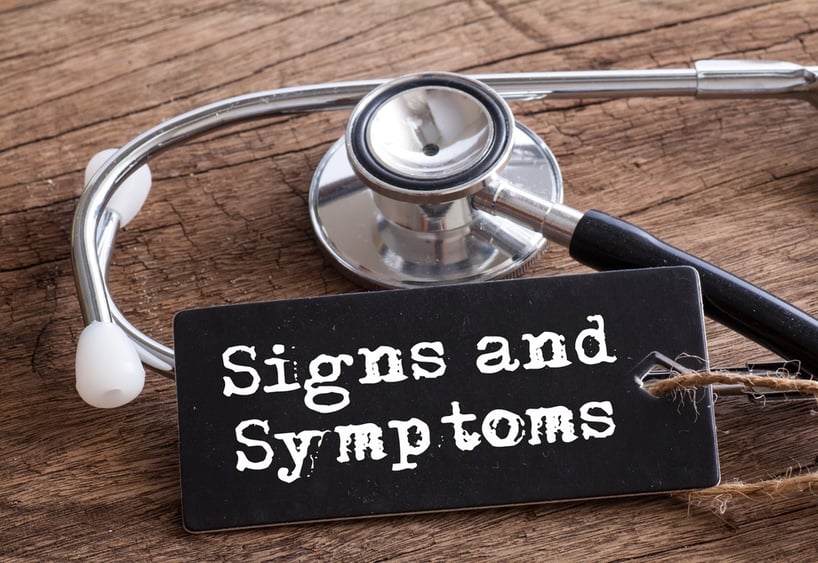What Is Ankylosing Spondylitis? (Signs, Symptoms, Risk Factors)
June 16th, 2017 | 3 min. read


According to the Centers for Disease Control (CDC), over two million Americans are estimated to have some form of ankylosing spondylitis (pronounced AN-kee-low-sing SPON-dil-eye-tiss), an autoimmune/inflammatory disease that primarily strikes the base of the spine.
Also called Bechterew's or Marie-Strumpell disease, ankylosing spondylitis (AS) is a chronic disease with no known cause and no known cure. Some research indicates a genetic predisposition; however, not all people with the genetic marker will develop this condition.

Early Signs and Symptoms of Ankylosing Spondylitis
The most common location for ankylosing spondylitis to begin is the area between the spine and pelvis, in the sacroiliac joint. Early signs include:
- pain in the lower back
- stiffness in the pelvis
- increased discomfort early in the morning, after sitting for a time, or following any inactive period
- neck pain
- increased fatigue
Additional pains may occur in seemingly unrelated locations, including:
- lower back (lumbar) vertebrae
- spinal joints
- back of the heel
- between the ribs and breastbone
- shoulder joints
Symptoms of ankylosing spondylitis will vary greatly from person to person, depending on each individual’s susceptibility, tolerance for pain and other factors.
In addition, these symptoms are characterized by their unpredictability. Symptoms of AS may get better, become worse, or even disappear at irregular intervals. In general, though, the pains get worse with rest and better with exercise.
Virtually all cases of ankylosing spondylitis report their symptoms occur in "flares": sharp, painful episodes of pain, which subside and appear to improve afterwards.
Advanced Signs and Symptoms of Ankylosing Spondylitis
In more extreme cases of ankylosing spondylitis, pain and inflexibility may occur throughout the body and maintain a constant level of discomfort.
For the most severe cases, the body will automatically begin building new bone in the most affected locations. This overgrowth of bone may result in spinal fusion: the actual elimination of natural gaps between the vertebrae in the spinal column. This condition is sometimes called "bamboo spine" and robs the body of its natural flexibility.
The unwanted new bone growth may affect the rib cage, which can greatly lessen the patient's ability to breathe freely. Other complications from severe AS include:
- Eye inflammation, resulting in pain, light sensitivity, and blurry vision
- Osteoporosis-like symptoms. The disease may cause bones to literally shrink, weakening the spinal bones and causing vertebral fractures.
- Heart disease. The disease may inflame the largest artery in the body, the aorta, which leads directly out of the heart. The swelling that accompanies inflammation may distort the aortic valve, interfering with its ability to regulate the blood pumping throughout the body.
Risk Factors for Ankylosing Spondylitis
Age, gender, and heredity appear to be the primary risk factors for developing ankylosing spondylitis. Specific risk factors for AS are:
- The condition is more likely to affect men than women.
- A.S. tends to first appear in people between the ages of 17 and 45, though it has been known to affect people of all ages and genders.
- Most patients with ankylosing spondylitis have the gene HLA-B27; however, the presence of the gene is no guarantee of the disease's manifestation.
- Family history. As with many afflictions, a family history of ankylosing spondylitis appears to correspond with increased chances of developing the condition.
- Medical history. People with frequent infections of the gastrointestinal (GI) tract may be more predisposed to develop AS.
The Mechanism of Ankylosing Spondylitis: Autoimmune Disease
Ankylosing spondylitis is an autoimmune disease, similar to some forms of arthritis.
Autoimmune diseases are characterized by the body mistakenly triggering its powerful immune system. Normally, the body defends us from infections by manufacturing white blood cells (phagocytes). For example, a large cut on your leg may allow bacteria to enter the body through the torn skin; the body automatically responds by creating and sending increased numbers of phagocytes into the bloodstream, where they will stream past the injured location and engulf and destroy any foreign microorganisms they find. The side effects of this protective system include increased blood flow to that affected area, resulting in redness, swelling, warmth, and sometimes pain and stiffness. Collectively, these effects are known as inflammation.
An autoimmune disease causes the body's immune system to backfire. A disease like ankylosing spondylitis causes the body to attack normal tissues. As a result, the normal tissues become inflamed, irritated, and swollen.
The inflammation that results from ankylosing spondylitis primarily targets the joints within the spine, particularly at the bottom of the spine and top of the hips. The swelling causes the cartilage caps within those joints to rub against each other, wearing them down, and eventually tearing them away.
The continued inflammation of AS will actually affect the hard tissues of the skeleton, tricking the body into growing unneeded bone, which results in the fused vertebrae seen in extreme cases of ankylosing spondylitis.
To learn more about Ankylosing Spondylitis contact Coastal Orhtopedics today at (361) 994-1166 or just click the button below to request an appointment today!
Article written by: Rob Williams, MD
Dr. Williams has been practicing orthopedic surgery in Corpus Christi since 1998. After graduating from Texas Tech hereceived his medical degree from the University of Texas at San Antonio. At the prestigious Campbell Clinic located at the University of Tennessee, Dr. Williams completed not only an Orthopedic Surgery Residency, but an additional year of Fellowship Training in Spine Surgery. Dr. Williams is dedicated to creating an excellent patient experience in the office or in the surgery suite.
Topics:


